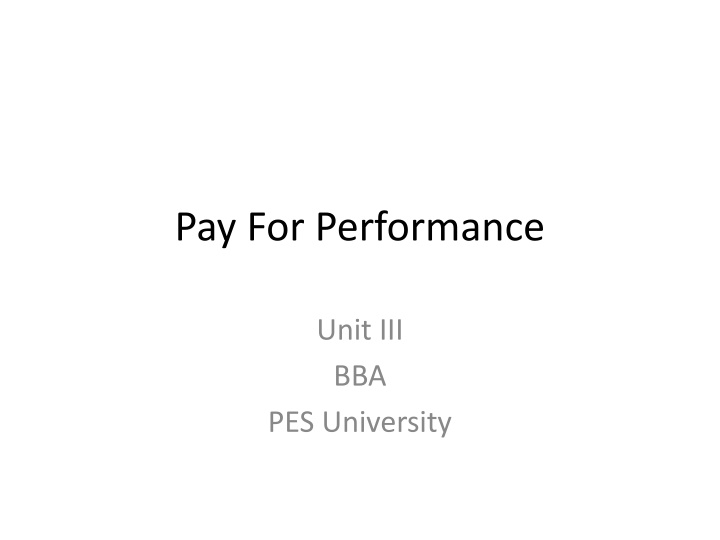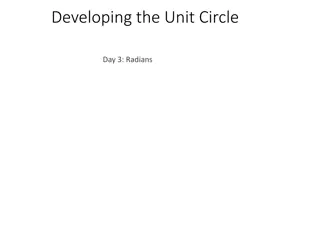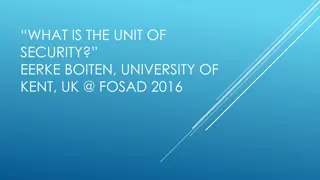
Effective Incentive Plans for Improving Employee Motivation
Discover the importance and effectiveness of incentives in enhancing employee motivation and productivity. Learn about various forms of incentives, how to create effective incentive plans, and different classification options to boost organizational performance.
Download Presentation

Please find below an Image/Link to download the presentation.
The content on the website is provided AS IS for your information and personal use only. It may not be sold, licensed, or shared on other websites without obtaining consent from the author. If you encounter any issues during the download, it is possible that the publisher has removed the file from their server.
You are allowed to download the files provided on this website for personal or commercial use, subject to the condition that they are used lawfully. All files are the property of their respective owners.
The content on the website is provided AS IS for your information and personal use only. It may not be sold, licensed, or shared on other websites without obtaining consent from the author.
E N D
Presentation Transcript
Pay For Performance Unit III BBA PES University
Incentives The term INCENTIVES mean, something which encourages a person to do something. Or the extra financial reward/ motivation . Incentives is the performance-link reward to improve motivation & productivity of the employees. Incentives includes all that provide extra pay for the extra performance in addition to regular wages for the job.
Why Incentives are Important? Incentives are considered beneficial to both employers as well as employees in following ways. Workers are likely to work at their best when they are offered monetary rewards for good performance. Provide opportunity for hard-working & ambitious employees to earn more. To improve work-flow, work methods & man machine relation ship. To bring employee involvement to make employee innovative. Incentives are the sound technique of improving productivity. Help to improve discipline and industrial relation. The cost of supervision are reduced. To obtain desired result.
What makes an Incentives plan effective? In the absence of mutual trust between management & workers, an incentives may be viewed as an attempt to improve production/ profit only. Incentive plan should be installed in consultation with workers & union. Payment of incentives should be free from bias & established through scientific/ proper work study. To implement incentives plane effectively minimum wages should be guaranteed to every workers. It should be easy to understand & simple to operate so that employee can calculate their own earnings. It should provide equal opportunity to all workers to earn incentives pay. Plan should not be very costly in operation. Plan should be flexible to adopt any changes later on. Payment of incentives should be prompt i.e. as early as possible. It should be adequate to motivate each employees. Every plan should be reviewed periodically.
Basic forms of incentives The basic from of incentives are as follow. Bonuses :- Is an incentive payment that is given to an employee beyond his normal standard wages. It is generally given at the end of the year & does not become part of the basic pay. The payment of bonus Act 1965 is applicable to every factory or establishment in which 20 or more person are employed in an accounting year. Merit pay :- is a reward based pay on how well an employee done the assigned job. Higher the performance Greater will be the reward. The payment is depend on individual employee s performance. Commission for sales people :- is paid on the basis of sales made by the employee, through different plan. Such as Salary plan :- where new salesman is appointed, is unable to generate new. Commission plan :- where organization is totally based on sales of their product. Combination of both :- is the most frequently used method.
Classification of Incentives Plans Incentives plans Organization- wide Individual Group Profit sharing Time-based Co-partnership Time-based Gain-sharing Output-based ESOPs
Individual Time based incentive plan Under time based plan, per hour wage rate is determined & incentives paid on the bases of time saved. All plans more or less follow same method i.e. (pay bonus on the basis of timed saved by employee). Output based incentive plan Under output based plan, per piece wage rate is determined & incentives paid on the bases of output produced. i.e. more output in standard time OR standard output in less time.
Organization- wide 1 Profit sharing Profit sharing is an arrangement by which employees receive in addition to wages, a share is fixed in advance in profit of the enterprise. It is an agreement between employer & his employee. According to International Labour Organization, Profit-sharing is a method of industrial remuneration under which an employer undertakes to pay to employee, a share in net profit of the enterprise in addition to regular wages Co-partnership Co-partnership is an extension of profit-sharing. Under this method worker s share in company s profit is paid in the form of share by which they become entitled to participate in decision-making process.
Organization- wide 2 Gain-sharing This method aims at increasing productivity & decreasing labour cost & sharing the result gains with employee. It is based on a mathematical formula which compares a standard perform with actual performance during given period. When actual performance exceed the standard performance, gains are shared with employees. ESOPs (Employee Stock Option Plans) This method is originated in the USA in early 90s. Under this plan, the eligible employee are allotted company s share below the market price. The term stokeoption implies the right of eligible employee to purchase a certain amount of stoke in future at an agreed price. The eligibility criteria may include length of service, contribution to the department etc
Group Group based or team-based incentives plans reward all team members equally based on overall performance of the team member. Under group based incentive plan, individual out put can t be measured. So team performance is evaluated on the basis of time taken rather than output produced, if team complete their target in well advanced to standard time the team member are eligible for incentives. Payment to team members may be made in the form of cash bonus or in the form of non-cash reward such as pleasure trip, times off or luxury items. Team based incentives foster cohesiveness among tem members.
Performance appraisal in fixing compensation (a) Factors for compensation hike. (b) Performance appraisal methods. (C) Process of fixing compensation based on performance appraisal. Shreyas Vaishnavi Sandesh
Executive Compensation Critical factor in attracting and retaining best managers
Meaning of executive: A person or group having administrative or managerial authority in an organization. The chief officer of a government, state, or political division It includes those individuals who are in the high managerial positions like Presidents, VP, Directors and general managers etc
Determining Executive Compensation Firms typically prefer to relate salary growth for the highest-level managers to overall corporate performance
Components of Executive Compensation Base salary Short-term(annual) incentives or bonuses Long-term incentives and capital appreciation plans Stock option plans Indexed stock option plans Executive benefits (Perks) Golden parachutes
Presentation Executive compensation-Aditya Rao
H R's Role in Executive Compensation HR executives who know their company s business must play key role in assuring reasonable and ethical behavior
Components of an Executive Compensation Package Base salary Short-term (annual) incentives or bonuses Long-term incentives and capital appreciation plans Executive benefits Perquisites
1) Basic Salary: It is determined through job evaluation and serves as the basis for other types of benefits. It varies by type of job, size of organizations, region of the country and the type of industry.
2) Short term incentives or Bonus: It is generally shortened . It is based on performance or profit sharing. There are several bonus schemes which is based on the system like ROI. Bonus plans are based on the subjective judgements of the BOD and the CEO.
3) Long-term incentives and capital appreciation plans Stock options are long term benefits offered to managers. It is one of the few wages offer large rewards to managers . Stock equivalences in the form of phantom stock or share appreciation rights
4) Executives benefits: It includes some items that other employees so not receive like traditional retirement, health insurance, vacations and others. Executive health plans with co-payments and corporate owned life insurance
5) Perquisites: Perks continues a main source of income for the executives. In addition to normal perks like PF, gratuity , managers also enjoy additional perks like parking plush office, vacation travel etc. Transportation Company car or car allowance First class air travel Company airplane usage Financial /Legal Financial planning Tax planning /tax preparation No or low interest loans Legal counselling Membership Country club Health club Other clubs
Features of Executive compensation: It cannot be compared with wages and salaries of non- managerial employees. Managers are denied the privilege of having unions and collective bargaining. Secrecy is maintained in respect of managerial remuneration. Managerial pay should not be individual performance measure . Manager s compensation is subject to statutory sealing's. Remuneration must be based on job description, job evaluation, salary grades with ranges of pay in each grade and salary surveys
Reasons for performance based compensation to executives: Attrition rate. Inequity in compensation. Statutory rules & regulations. Globalization of the talent market.
Theories of Executive compensation: 1) Marginal Productivity Theory. 2) Governance Theory a)Managerialism b)Agency theory 3) Structural Theory 4) Human Capital Theory 5) Symbolism Theories a) Tournament theory b) Political strategists.
1) Marginal theory: Marginal productivity theory is mainly concerned with predicting the pay levels of executives. According to this theory executive compensation are made with a context of analyzing the firm s ability to generate profits and maximize productive output. Two main conclusions: The size of the executive pay package reflects the firm s net profits. executive compensation=profits 2. The size of the executive pay package is proportional to the executive s marginal revenue product 1.
The practical implication of marginal productivity theory is that both the firm s profitability and the executive s relative economic contribution are pay-level determinants. This theory can explain the star system
2) Governance theory: It is held that executives should pursue strategies that will create long- term shareholder value and that they should receive closely related rewards. According to this theory, it is believed that a hired executive will act in the best interests of the owners if he has a personal ownership stake It deals with the issues arising when the firm s owners are removed from the decision-making processes of the executive. Managerialism and agency theories are subsets of governance theory
3) Managerialism The separation of ownership and control in organizations can lead to executive pay decisions that benefit the executive regardless of what the organizational outcomes and effects might be on shareholders. An executive in such a firm is more likely to have a pay package that will increase when firm performance is good and remain at the same level even when the firm performance is poor.
4) Agency theory: Agency theory may be considered as a theoretical extension of managerialism. A firm s owners are called the principals and the hired executives are called the agents. This theory is based on the assumption that the primary relation of an executive is with the shareholders. According to this theory, shareholders design the compensation of the top executives, keeping in mind their mutual interests. This theory is viewed as a contract of resource holders shareholders and the top executives.
It is the agency between the shareholders and agents. The compensation is designed in such a way that it serves the best of the shareholders as well as the executives The agent may pursue activities that benefit him rather than the firm s owners. This represents an agency cost to firm owners which is the difference between net profits of the firm had the owners been the managers and the net profits under the agent s stewardship.
5) Structural theory: According to this theory, organisations attempt to maintain particular salary differentials between the management and subordinate levels to comply with cultural norms of proportionality. It examines executive compensation at the firm level. It focuses on the social standards of pay at different hierarchical levels
6) Human capital theory: Human capital theorists examine the individual characteristics of the executive in attempting to predict pay levels. These characteristics include factors that are intrinsic to the executive such as his knowledge base. It is possible to calculate a rate of return on investments made in human capital. It predicts how much the firm will pay for his services.
7) Symbolism theory: It states that the power and political influence are the primary determinants of his pay level. a) b) Political strategists. Tournament theory
a) Tournament theory: It holds that the amount of compensation received by executives of an organization is similar to tournament winnings. It may not allow them to acquire all the skills of next higher positions. The prospect of this prize post sends powerful signals throughout the organization that by working harder one may win the number one post Focus is on the motivational properties that executive compensation levels brings to those in the lower level of the organization.
b) Political strategists: The political strategist theory tends to ignore the rational justifications of executive compensation. It pays more attention towards the executive s ability to cater to the needs of the multiple constituents of the firm such as board members, shareholders, customers, Government and the general public.
Executive compensation design: 1. Analyze existing benefit plans and executive compensation arrangements. Establish primary plan objectives for executive compensation program. Identify optimal plan design features. Determine tax and distribution strategy. Select appropriate financing methodology. Establish guidelines for periodic review and evaluation. 2. 3. 4. 5. 6.
Nature of people who enter profession Organizational strategy Market maturity Competitor practices Economic environment Product sold
Sales Compensation Packages Guaranteed base salary Guaranteed base salary + commission Guaranteed base salary + bonus Guaranteed base salary + commission + bonus Commission only Combination plan
Perquisites, or Perks Executive Perquisites are those benefits provided to executives above and beyond benefits provided to all other employees. Generally, executive perquisites include office space, parking, cell phones, company car, club memberships, first class air travel, corporate aircraft, employment contracts, legal and financial services, severance agreements, change in control agreements, special deferred compensation, disability and life insurance.
Voluntary Retirement / Separation Schemes, Golden handshake: One of the techniques of trimming the workforce is Voluntary Retirement Scheme (VRS). This is generous, tax-free severance payment to persuade the employees to voluntarily retire from the company. The scheme has its origin during early 1990s in USA . this scheme is also known as Golden hand Shake as it is the golden route to retrenchment. The VRS is most Human technique for downsizing the workforce
Benefits under this scheme The minimum benefits under this scheme include- The employee opted for VRS entitles for 45 days emolument for each completed year of service or monthly emoluments at the time of retirement multiplied by the remaining months of service before normal date of retirement whichever is less. In addition to these emoluments, the employee will get the provident fund and gratuity dues. The VRS originally granted tax-exemption for amount up to Rs. 5 lakhs received by public sector employee as his severance pay- package.
Eligibility for VRS: It varies from company to company. Incase public sector company, employees who have attained 40 years of age or completed 10 years of service are eligible for VRS Merits: It offers best and human route to retrenching excess of employee Lucrative settlement prevents resentment Voluntary nature preludes the need for enforcement It allows for lowering the overall wage bill and enables for increase in salary .
Demerits It creates a sense of fear and uncertainty among the employees who stay with the organization Operation of the scheme creates bad reputation of the company
Criteria of effective managerial compensation: General factors: 1) Salary /Basic salary/consolidated salary. 2) Grade-wise flat allowances. 3) Reimbursement of expenses 4) Annual payments 5) Extra benefits 6) ESOP 7) Traditional compensation package. 8) Transparency in pay package. 9) Flexible pay package 10) Performance linked package 11) Lifestyle perks.






















